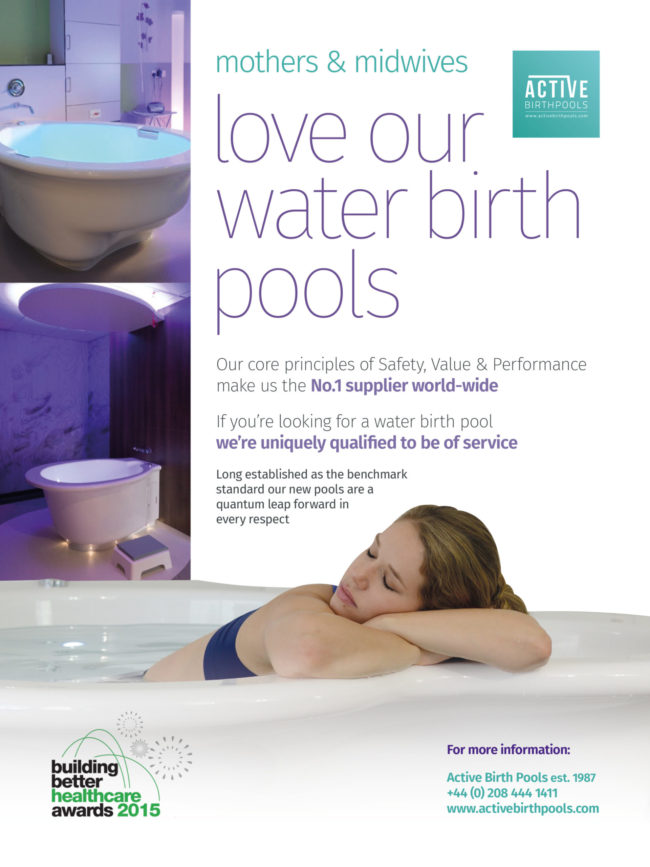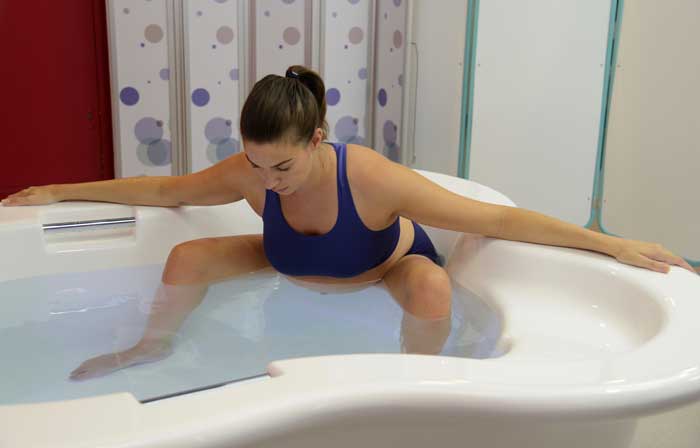Otigbah CM; Dhanjal MK; Harmsworth G; and others, (July 2000).
European Journal of Obstetrics and Gynecology and Reproductive Biology , vol 91, no 1, July 2000, pp 15-20.
Setting, participants, design and aim:
The study took place in a district general hospital over a five year period, 1989-1994 and involved a total of 602 mothers. A retrospective case-control study which analysed data on 301 mothers who had a water birth and another 301 who had a normal land birth.
The aim was to explore the effects of water immersion on labour and birth, as compared with normal land birth.
Method: The study centre had several pool selection criteria which accepted women who were considered to be at low risk of complication for the pool.
They were required to have: * no medical or obstetric problem; * a gestation of at least 38 weeks with a normal sized fetus; * cephalic presentation; * clear liqour if membranes were already ruptured; * a reactive admission cardiotocograph.
The controls were selected from the unit’s audit data, as the next parity matched woman who was low risk, had a normal birth and did not have labour augmentation.
The variables compared and analysed included: * labour length; * analgesia uptake; * Apgar scores; * maternal complications – namely perineal trauma, postpartum haemorrhage and infection; * neonatal complications – namely shoulder dystocia, admission to special care baby unit (SCBU) and infection.
Data were analysed using the Chi-squared test to compare proportions, and Student’s t test to compare means. Any difference was considered significant if the P value was <0.05. Results: * Primigravidae who had a water birth had a significantly shorter first stage (P <0.05) and second stage (P <0.005) of labour.
The total labour length was 90 minutes shorter; * Water birth mothers, whatever their parity, used significantly less opioid pain relief, either alone or in addition to entonox – 1.3% compared to 54% of the controls (P <0.0001).
A total of 38% water birth women had no analgesia compared to 8% of the control group (P <0.0001); * Water birth mothers had significantly fewer episiotomies – 5%compared to 25% (P <0.0001), although they had more vaginal, 1° and 2° perineal tears overall – 53% versus 39% (P <0.001).
Water birth primigravidae had more intact perinea – 41% compared to 36%, although this was not statistically significant; * Fewer postpartum haemorrhages occurred among water birth mothers – 1.3% versus 2.7%; * One case of maternal pyrexia was reported on a multiparous water birth woman who was treated with antibiotics; she had no positive cultures on subsequent sampling; * No significant difference was reported between the groups in the mean Apgar scores at one and five minutes; *
Two water birth babies were admitted to SCBU with low Apgars.
In one case there was a true knot in the umbilical cord and the other followed a difficult delivery with an unexpected compound presentation; * Five babies in the water birth group and four in the control group had shoulder dystocia; * No neonatal infections were reported.
Abstract writer’s comments:
This is clearly an interesting and worthwhile study which includes data on a good size sample of mothers and babies.
A key strength is the analysis and presentation of the data by parity as often findings relating to primigravidae and multigravidae are amalgamated, despite the influence of parity on factors such as use of analgesia, labour length and type of delivery.
The authors acknowledge the limitations of a non-randomised water group sample.
It would have been interesting to have collected information relating to the social class of pool users, as there is an assumption among health professionals that birthing pools attract greater interest among middle class women, but I know of no evidence to support this view.
The researchers report a shorter labour for water birth primigravidae but do not mention the frequency of vaginal examinations, or whether the second stage was timed when the presenting part was visible, making the precise process of how they timed these labour stages unclear.
The effect of water immersion on analgesia uptake appears striking.
The authors suggest that an influencing factor may have been the continuous midwifery care, often by a known midwife, for pool users, as opposed to an intermittent midwifery presence by a midwife unknown to a mother before her labour.
There is, however, no mention whether any facilities such as beanbags, birthing balls, rocking chairs or floor mattresses were available to women who did not use the pool, apart from presumably a delivery bed.
It is therefore not known whether these women were encouraged to adopt comfortable positions and be as mobile as possible throughout labour.
The practice of maximising maternal mobility has been shown to reduce the perception of pain and thus the uptake of analgesia.
Whilst it is reassuring that fewer episiotomies were performed on water birth women, nonetheless, fifteen still had one!
It would be interesting to know something about the study centre’s approach to care during the second stage regarding pushing techniques and time perimeters, as this could have influenced the incidence of both tears and episiotomies.
The researchers note that ‘particular care was taken to ensure controlled delivery of the head’ (p16) but do not explain how, ie if the midwife touched the head and perineum or not.
Besides, tears often occur with the birth of the shoulders.
Comparison was made between the groups on the incidence of postpartum haemorrhage, but no mother appeared to have a completely physiological third stage because the cord was clamped and cut promptly after the birth, which disturbs the physiology, and the placentas were delivered out of the pool.
The rationale for leaving the pool was to estimate blood loss more accurately – a difficult thing to achieve in or out of water.
A second reason was the totally unproven risk of water embolism.
This study reported no adverse effect for mothers or babies associated with water immersion during labour and birth and forms a useful basis for future research.










